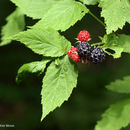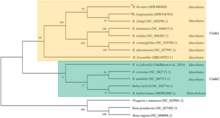pt-BR
nomes no trilho de navegação


Rubus occidentalis (lat. Rubus occidentalis) - gülçiçəyikimilər fəsiləsinin moruq cinsinə aid bitki növü.
Rubus occidentalis (lat. Rubus occidentalis) - gülçiçəyikimilər fəsiləsinin moruq cinsinə aid bitki növü.
Die Schwarze Himbeere (Rubus occidentalis)[1] ist eine im östlichen Nordamerika beheimatete Rubus-Art aus der Familie der Rosengewächse. Ihren englischen Trivialnamen black raspberry teilt sie mit der eng verwandten westamerikanischen Oregon-Himbeere (Rubus leucodermis). Gelegentlich werden auch weitere Namen verwendet wie wild black raspberry, black caps, black cap raspberry, thimbleberry,[2][3] und scotch cap.[4]
Rubus occidentalis ist ein laubabwerfender Strauch von 2 bis 3 Metern Höhe mit stacheligen Trieben. Die Blätter sind gefiedert; jedes Blatt besteht aus fünf Blättchen auf den im ersten Jahr stark wachsenden Trieben und aus drei Blättchen an den blühenden Zweigen. Die Blüten bestehen aus langen, schlanken Kelchblättern (6–8 mm), die mehr als doppelt so lang sind wie die Kronblätter. Die kugelige Frucht ist eine Sammelfrucht von 12 bis 15 Millimetern Länge, die aus Steinfrüchten zusammengesetzt ist; sie ist essbar und weist hohe Gehalte an Anthocyanen und Ellagsäure auf.[5]
Wie aus dem Trivialnamen abzuleiten ist, haben schwarze Himbeeren sehr dunkle, violett-schwarze Früchte, die durch die Anthocyan-Pigmente gefärbt sind. Es kommt jedoch zu gelegentlichen Mutationen in den Genen, welche die Anthocyan-Produktion regulieren, so dass gelbfrüchtige Varianten („gelbe Himbeeren“, englisch yellow raspberries) entstehen, die gelegentlich auch von Sammlern und Hofläden im Mittleren Westen (namentlich in Ohio) vermarktet werden. Die gelbfrüchtigen Varianten behalten den einzigartigen Geschmack der schwarzen Himbeeren, was sie von den ähnlich erscheinenden blassen Varianten kultivierter roter Himbeeren unterscheidet, die im Allgemeinen aus der eurasischen Rubus idaeus, manchmal der nordamerikanischen Rubus strigosus und anderen aus Hybriden dieser beiden Arten entstandenen Sorten hervorgegangenen sind.
Schwarze Himbeeren enthalten viele Anthocyane. Dies trägt dazu bei, sie als natürliches Färbemittel zu nutzen. Vorläufige Studien an Versuchstieren zur Beurteilung ihrer Wirkung gegen Krebs sind im Gange[6] und eine kleinteilige klinische Studie wurde an Patienten mit Barrett-Ösophagus durchgeführt.[7]
Das Zentrum der kommerziellen Produktion von Schwarzen Himbeeren in den USA bildet das Willamette Valley in Oregon. Die Hauptsorte, „Munger“, wird auf etwa 600 ha angebaut. Weitere Sorten sind „John Robertson“, „Allen“, „Jewel“, „Blackhawk“, „Macblack“, „Plum Farmer“, „Dundee“, „Hanover“ und „Huron“. Die Pflanzen werden im Sommer von Hand gepflanzt, im Winter mechanisch ausgeästet und dann maschinell geerntet. Die Hektar-Erträge sind im Allgemeinen niedrig, weshalb die Früchte meist teuer sind.
Die Art wurde zur Zucht vieler Rubus-Hybriden genutzt; rote bis schwarze Himbeeren werden meist als violette Himbeeren vermarktet; „Brandywine“, „Royalty“ und „Estate“, sowie Rubus × neglectus 'Glen Coe' sind Beispiele für violette Himbeer-Sorten. Es wurden auch wilde violette Himbeeren an verschiedenen Orten im nordöstlichen Nordamerika gefunden, wo zwei Elternarten gemeinsam vorkommen und gelegentlich auf natürliche Weise hybridisieren.
Die Beeren werden normalerweise getrocknet oder gefrostet, püriert und gesaftet, oder als Farbmittel verarbeitet. Frische Beeren werden aber auch saisonal vermarktet. Zu den bekannten Likören, die aus schwarzen Himbeeren hergestellt werden, gehören der französische Chambord Liqueur Royale de France. Ein ähnlicher Likör aus Korea, der ursprünglich aus den schwarzen Früchten der Rubus coreanus hergestellt wurde, wird heute auch aus den Schwarzen Himbeeren hergestellt.
Eine positive Eigenschaft der dunklen Beeren ist die im Vergleich zu den roten normalen Kultur Himbeeren die dickere Fruchthaut. Man kann die Beeren sehr gut einfrieren und durch die festere Haut auch wieder einzeln gefroren herausnehmen.
Die schwarzen Himbeeren sind eng mit den rotfrüchtigen Arten Rubus idaeus und Rubus strigosus verwandt; sie haben alle die markante weiße Unterseite der Blätter sowie Früchte, die sich reif leicht vom Karpell lösen, aber die Früchte differieren in der Farbe, die eben bei R. occidentalis schwarz sind; auch die Stängel sind stacheliger. Die schwarzen Früchte verleihen ihnen das Aussehen von Brombeeren, obwohl dies nur oberflächlich betrachtet so ist. Der Geschmack ist einzigartig und nicht mit dem roter Himbeeren oder Brombeeren zu vergleichen.
The Plant List, ein Gemeinschaftsprojekt der Royal Botanic Gardens (Kew) und des Missouri Botanical Garden führt die folgenden Synonyme auf:[8]
Die Schwarze Himbeere (Rubus occidentalis) ist eine im östlichen Nordamerika beheimatete Rubus-Art aus der Familie der Rosengewächse. Ihren englischen Trivialnamen black raspberry teilt sie mit der eng verwandten westamerikanischen Oregon-Himbeere (Rubus leucodermis). Gelegentlich werden auch weitere Namen verwendet wie wild black raspberry, black caps, black cap raspberry, thimbleberry, und scotch cap.

Rubus occidentalis is a species of Rubus native to eastern North America. Its common name black raspberry is shared with other closely related species. Other names occasionally used include bear's eye blackberry, black cap, black cap raspberry,[3][4] and scotch cap.[5]
Rubus occidentalis is a deciduous shrub growing to 2 to 3 metres (6.6 to 9.8 ft) tall.[6] The leaves are pinnate, with five leaflets on leaves, strong-growing stems in their first year, and three leaflets on leaves on flowering branchlets. The flowers are distinct in having long, slender sepals 6 to 8 millimetres (0.24 to 0.31 in) long, more than twice as long as the petals. The round-shaped fruit is a 12-to-15-millimetre (0.47 to 0.59 in) diameter aggregation of drupelets; it is edible, and has a high content of anthocyanins and ellagic acid.[7][8]
Long stems also called canes grow up to 1.8 metres (5.9 ft) in length, usually forming an arch shape, but sometimes upright. Canes have curved, sharp thorns, while immature canes are unbranched and have a whitish bloom.[9]
The black raspberry is related to the red raspberry Rubus idaeus and Rubus strigosus, sharing the white underside of leaves,[10] and fruit that readily detaches from the carpel.[9]
The plant grows in disturbed areas, especially those that are logged or cut. It is also found in meadows, and near streams and lakes, trails or roadways.[9] The native range of Rubus occidentalis extends as far east as New Brunswick, as far west as Nebraska, as far north as Quebec, and as far south as Mississippi.[11]
Apple mosaic virus, black raspberry necrosis virus, Elsinoë veneta, raspberry bushy dwarf virus, raspberry leaf curl virus, Rhizobium radiobacter, Rhizobium rhizogenes, Didymella applanata, Monilinia fructigena, Peronospora sparsa, and Peridroma saucia all infest black raspberries.[12]
Common black raspberry cultivars include: Black Hawk, Bristol, Jewel, Cumberland, Morrison, Munger, and Logan.[13]
The center for black raspberry production is in the Willamette Valley in Oregon. The main cultivar, 'Munger', is grown on about 600 hectares (1,500 acres). Other cultivars include 'John Robertson', 'Allen', 'Jewel', 'Blackhawk', 'Macblack', 'Plum Farmer', 'Dundee', 'Hanover', and 'Huron'. The plants are summer tipped by hand, mechanically pruned in winter and then machine harvested. The yields are generally low per acre and this is why the fruits are often expensive.
The species has been used in the breeding of many Rubus hybrids; those between red and black raspberries are common under the name purple raspberries; 'Brandywine', 'Royalty', and 'Estate' are examples of purple raspberry cultivars. Wild purple raspberries have also been found in various places in northeastern North America where the two parental species co-occur and occasionally hybridize naturally.
The berries are typically dried or frozen, made into purées and juices, or processed as colorants. Fresh berries are also marketed in season. Two well-known liqueurs based predominantly on black raspberry fruit include France's Chambord Liqueur Royale de France and South Korea's various kinds of Bokbunja-ju.
Black raspberry — watercolor, 1893
A punnet of black raspberries
{{cite web}}: CS1 maint: others (link) Note that this website has been superseded by World Flora Online {{cite web}}: CS1 maint: url-status (link) {{cite web}}: CS1 maint: url-status (link)  Rubus phylogenetic tree
Rubus phylogenetic tree Rubus occidentalis is a species of Rubus native to eastern North America. Its common name black raspberry is shared with other closely related species. Other names occasionally used include bear's eye blackberry, black cap, black cap raspberry, and scotch cap.
Rubus occidentalis, la frambuesa negra, es una especie de Rubus nativa del este de Norteamérica. El nombre común frambuesa negra, es compartido con la cercana Rubus leucodermis del oeste de América del Norte.
Rubus occidentalis un arbusto que alcanza una altura de entre 2–3 m.
Está estrechamente emparentada con la frambuesa roja originaria de Europa (Rubus idaeus), mostrando el distintivo anverso blanco de las hojas. La fruta es similar a la Zarzamora, pero solo en apariencia, ya que el sabor es más parecido al de la frambuesa; por lo que en algunos lugares es confundida con la zarzamora.
Rubus occidentalis fue descrita por Carlos Linneo y publicado en Species Plantarum 1: 493. 1753.[1]
Ver: Rubus
occidentalis: epíteto latíno que significa "del oeste"[2]
Rubus occidentalis, la frambuesa negra, es una especie de Rubus nativa del este de Norteamérica. El nombre común frambuesa negra, es compartido con la cercana Rubus leucodermis del oeste de América del Norte.
Rubus occidentalis
Rubus occidentalis est une espèce de Rubus originaire de l'est de l'Amérique du Nord . Son nom commun de framboise noire est partagé avec d' autres espèces étroitement apparentées . D'autres noms occasionnellement utilisés incluent la mûre d’œil d'ours , la casquette noire , la framboise noire de casquette et la casquette écossaise .
Rubus occidentalis est un arbuste à feuilles caduques atteignant 2 à 3 mètres (6,6 à 9,8 pieds) de hauteur.[1]
Le feuillage caduc est fait de feuilles ovales, dentées, alternes, de couleur vert pâle.[2]
Les fleurs sont blanches à cinq pétales plus courts que les sépales.[2]
Elle pousse dans un sol de tout genre, de préférence acide et plutôt sec, dans les champs incultes, le long des fossés, des chemins, et à la bordure des bois.[2]
Analogue à Rubus idaeus *, plus actif contre les spasmes.
Se consomme comme le framboisier rouge.
Rubus occidentalis
Rubus occidentalis est une espèce de Rubus originaire de l'est de l'Amérique du Nord . Son nom commun de framboise noire est partagé avec d' autres espèces étroitement apparentées . D'autres noms occasionnellement utilisés incluent la mûre d’œil d'ours , la casquette noire , la framboise noire de casquette et la casquette écossaise .
Rubus occidentalis là loài thực vật có hoa trong họ Hoa hồng. Loài này được L. miêu tả khoa học lần đầu tiên năm 1753.[1]
Rubus occidentalis là loài thực vật có hoa trong họ Hoa hồng. Loài này được L. miêu tả khoa học lần đầu tiên năm 1753.